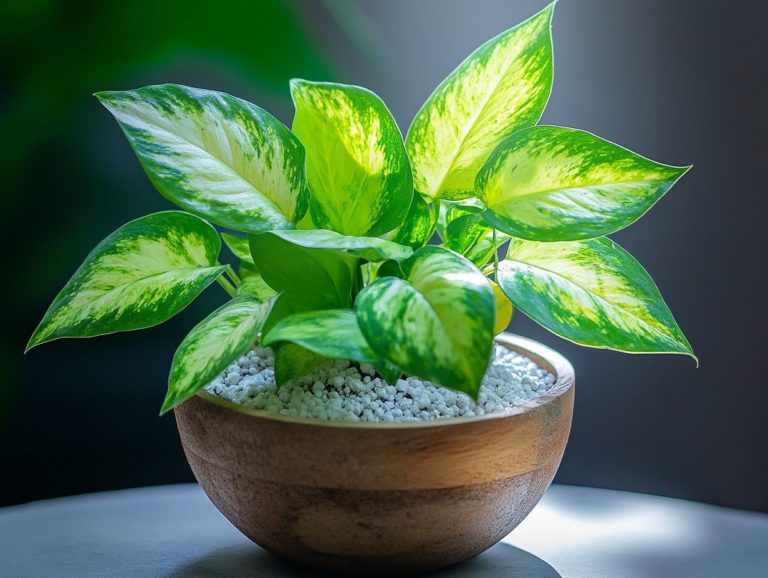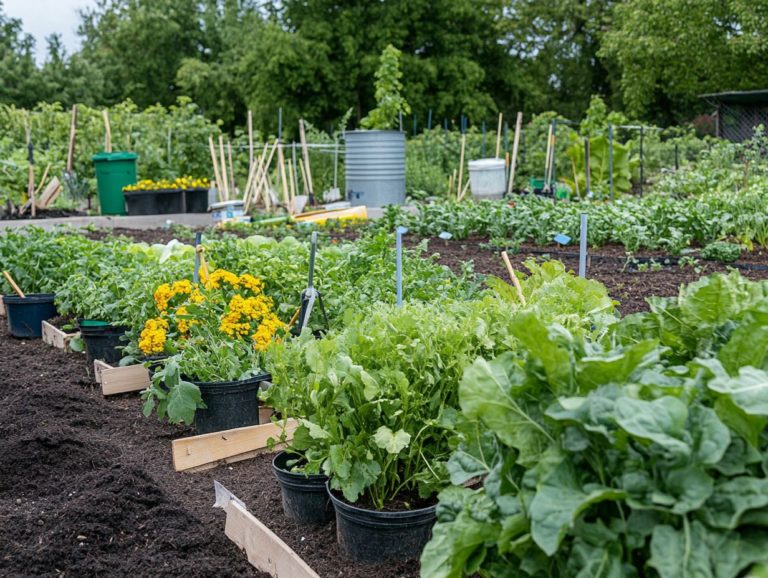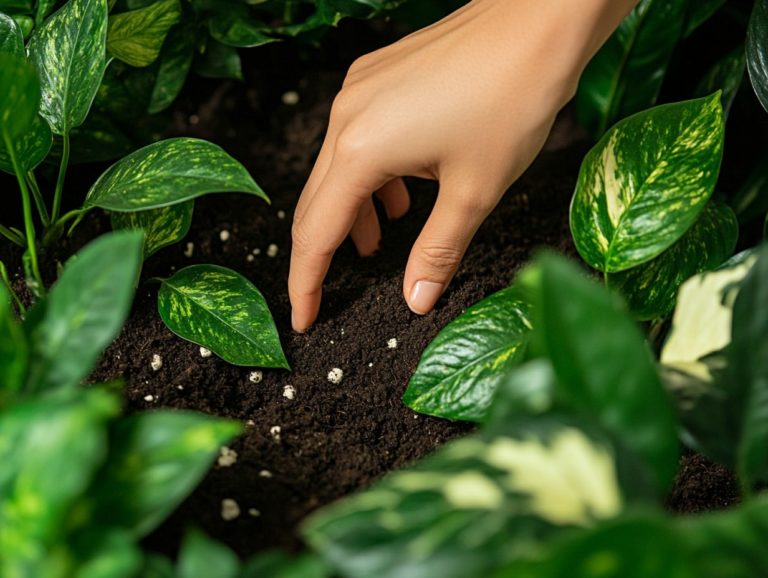How to Maintain Soil Moisture for Indoor Plants
Soil moisture is essential for the health and vitality of your indoor plants. Recognizing its significance and understanding how various factors influence moisture levels will empower you to create the ideal environment for your green companions.
This article delves into effective methods for maintaining soil moisture, covering everything from proper watering techniques to the strategic application of mulch. It highlights how to identify signs of under- or overwatering and offers solutions for common moisture-related challenges.
Get ready to nurture your plants to their fullest potential!
Contents
Key Takeaways:

- Proper watering techniques are essential for maintaining soil moisture. This includes monitoring environmental conditions and the specific needs of each plant.
- Mulching and controlling humidity also help retain soil moisture. These methods trap moisture and prevent evaporation.
- Identifying signs of under- or overwatering and troubleshooting common moisture problems (like how water moves through the soil) are key to ensuring healthy soil moisture for indoor plants.
The Importance of Soil Moisture for Indoor Plants
Maintaining optimal soil moisture levels is crucial for the health and growth of your indoor plants, as it directly impacts nutrient absorption, root systems, and overall plant vitality.
When you manage soil moisture effectively, you significantly reduce the risk of common problems like overwatering and underwatering. Both can lead to issues such as root rot and compromised plant health. A soil moisture meter is a great tool. It helps you check moisture levels accurately.
This ensures that your moisture-loving plants thrive and flourish in your indoor sanctuary.
Why Soil Moisture Matters
Soil moisture is essential to your plant care routine, acting as a reservoir for the nutrients that promote healthy growth and strong root systems.
By maintaining optimal moisture levels, you’ll enable your plants to effectively absorb vital nutrients like nitrogen, phosphorus, and potassium, all of which are crucial for their overall vigor. Proper moisture levels can also help you avoid common problems like root rot, which frequently occurs in overly wet conditions, leading to decayed roots and stunted growth.
If the soil is too dry, your plants will struggle to access the essential minerals they need, putting their health at risk. Consider integrating moisture retention strategies, such as adding organic mulch or using drip irrigation. These techniques significantly enhance your soil moisture management, resulting in resilient, thriving plants.
Factors Affecting Soil Moisture Levels
Several interconnected factors influence soil moisture levels in your indoor garden. These include environmental conditions, the types of plants you choose, and the specific watering preferences unique to each variety.
Understanding how these elements interact can significantly enhance your plant care routine.
Environmental Conditions
The environmental conditions in which you place your indoor plants have a significant impact on soil moisture levels. Factors like humidity and temperature control play crucial roles.
In a high-humidity environment, your plants can truly thrive. The excess moisture in the air helps reduce evaporation from the soil, ensuring a consistent hydration level. If humidity is low, you risk rapid soil moisture depletion, leading to root stress and stunted growth. It s vital for you, as a plant care enthusiast, to establish an indoor climate that mirrors your plants’ native habitats.
For tropical plants, keeping humidity levels around 60-80% can promote lush growth, while succulents and cacti thrive in drier conditions, ideally aiming for 30-50% humidity. By fine-tuning these conditions, you can create optimal environments that support healthy, moisture-rich soil, ultimately enhancing your plants’ vitality and resilience.
Plant Types and Needs

Different plant types have unique requirements regarding soil moisture. While some, like succulents, thrive in well-drained soil, others, such as moisture-loving plants, prefer rich, damp environments.
Take the resilient ZZ plant, for example. It can adapt to various conditions. However, it truly shines in soil that drains well, helping it avoid the dreaded rot that comes from being too wet.
On the other hand, peace lilies revel in consistently moist soil. They favor nutrient-rich options that retain water without becoming soggy.
Understanding these subtleties will not only enhance your plant care efforts but also help you cultivate a vibrant indoor garden. By customizing your watering strategies and selecting the right soil types—think sandy mixes for succulents and peat-based blends for those moisture enthusiasts—you can create the ideal habitat for your green companions. For more insights, check out the science of watering indoor plants.
Methods for Maintaining Soil Moisture
Employing effective methods to maintain soil moisture is crucial for the health of your indoor plants. This involves a range of strategies, including proper watering techniques, the application of mulch, and careful humidity control.
You can ensure your plants thrive by mastering these approaches!
Proper Watering Techniques
Implementing proper watering techniques is essential for maintaining soil moisture. Using a tool like a soil moisture meter which measures how wet or dry the soil is can help you establish an effective watering schedule.
Plus, leveraging such tools, grasping various watering techniques will greatly enhance your plant care. For instance, a consistent manual watering routine not only keeps the soil balanced but also nurtures robust root growth.
When you use a watering can, it’s crucial to target the base of the plant, minimizing evaporation and ensuring that water reaches the roots directly.
By regularly monitoring moisture levels, you can prevent issues like overwatering, which can lead to root rot, or underwatering, resulting in wilted leaves. Developing good habits around these practices will enable you to nurture healthier plants that truly thrive.
Using Mulch to Retain Moisture
Utilizing mulch is an exceptional strategy for retaining moisture in your potting soil. Options like organic mulch and compost play a crucial role in enhancing nutrient retention.
By creating a protective layer on top of the soil, mulch prevents moisture from evaporating and regulates soil temperature. This makes it incredibly beneficial for your indoor plants.
Various types of mulch, such as shredded bark or straw, can improve drainage while also introducing organic matter that nourishes beneficial microorganisms.
If you re setting up your indoor plant haven, consider applying a two to four-inch layer of mulch. Make sure to keep it slightly away from the plant’s stem to avoid rot. This thoughtful approach not only enhances soil health but elevates your growing environment into a truly vibrant and sustainable oasis.
Humidity Control
Maintaining humidity control is essential for your plants hydration, as fluctuations can directly impact soil moisture levels and their overall health.
To create a stable environment, consider using humidity trays filled with water and pebbles. This setup allows the water to evaporate slowly, maintaining moisture in the air without oversaturating the soil.
You might also want to strategically deploy humidifiers to boost humidity levels, especially in dry indoor areas. These practices not only promote consistent soil moisture but are crucial for developing healthy root systems and lush foliage.
By ensuring your plants receive the right balance of hydration, you can cultivate vibrant greenery, minimize stress, and encourage robust growth. Managing humidity is key to achieving indoor gardening success!
Signs of Under or Overwatering

Recognizing the signs of underwatering and overwatering is essential for effective plant care. Both conditions can result in serious repercussions, such as root rot and waterlogged soil, which are detrimental to your plants’ health.
Identifying and Addressing Issues
Effectively identifying and addressing issues related to soil moisture is essential for maintaining optimum plant health and preventing conditions like root rot.
Knowing how moisture affects plants is key for both gardeners and farmers. Regularly checking moisture levels helps diagnose problems like overly dry soil or excessive saturation. This allows for timely interventions before issues escalate.
Utilizing moisture meters or simple finger tests enables you to assess the soil’s condition instantly. If you notice signs of water stress, you can take actionable steps like adjusting irrigation schedules, improving soil drainage, or adding mulch to correct these issues.
This proactive approach not only safeguards plant health but also fosters vigorous growth.
Troubleshooting Common Soil Moisture Problems
Troubleshooting common soil moisture issues is crucial for maintaining the vitality of your indoor plants. Problems like drainage issues and mold growth demand your immediate attention to ensure a thriving green environment.
Solving Drainage Issues
Solving drainage issues is essential for preventing waterlogged soil, which can lead to root rot and reduced nutrient uptake.
To tackle these challenges effectively, adopt a two-step method focused on selecting the right soil types and incorporating specific additives to enhance drainage capabilities. By using well-draining soils, like sandy loam or a mix containing perlite (a lightweight material that improves soil drainage) or pumice, you can create an environment that allows water to flow freely while still retaining essential moisture.
Adding organic matter, such as compost, can further enhance the soil structure, promoting better aeration and moisture regulation. Implementing effective wondering techniques for indoor plants like creating raised beds or utilizing drainage tiles can also play a crucial role in achieving a healthy balance between moisture retention and drainage, ultimately leading to thriving indoor gardening outcomes.
Dealing with Mold and Fungal Growth
Fight mold and fungal growth to keep your plants thriving! Excessive humidity and damp conditions can exacerbate these issues, turning your once-thriving oasis into a breeding ground for unwelcome guests.
To effectively combat mold and fungi, regularly monitor humidity levels with hygrometers and ensure your indoor plants are situated in well-ventilated spaces. Good airflow helps plants dry out quickly, preventing moist soil from becoming a haven for fungal spores.
Choosing the right potting mixtures and using pots with drainage holes can significantly reduce moisture retention, giving your plants a fighting chance.
For treatment, consider using organic fungicides or homemade remedies, such as a diluted vinegar solution, to target affected areas. By regularly inspecting your plants for signs of distress, you’ll be able to intervene promptly, keeping your green companions vibrant and healthy.
Frequently Asked Questions

How can I maintain soil moisture and watering for my indoor plants?
To maintain soil moisture, use a moisture meter to regularly check moisture levels in the soil. Incorporate mulch or peat moss to help retain moisture. Group plants with similar moisture needs together to benefit from a consistent watering schedule.
The frequency of watering your indoor plants will depend on factors like plant type, soil type, and the surrounding environment. Generally, indoor plants should be watered when the top inch of soil feels dry to the touch. Avoid overwatering to prevent root rot.
If you have more questions or need advice on indoor plant care, feel free to ask!
What are the signs that my indoor plants need more moisture?
Look out for wilting leaves, dry or brown edges, and soil that feels dry. These signs indicate your plants might need more water.
Can I use tap water for my indoor plants?
Yes, you can use tap water. Just be aware that some tap water contains chemicals that could harm your plants.
If you’re worried about water quality, let the tap water sit overnight or use filtered water.
How can I stop soil moisture from evaporating too quickly?
One effective way is to add a layer of mulch or peat moss to the soil’s surface. This will help retain moisture and slow evaporation.
Consider placing a saucer under your plant; it catches excess water, creating a humid environment.
Can I overwater my indoor plants while trying to keep the soil moist?
Yes, it’s possible to overwater your plants. Be mindful of your plants’ specific needs and adjust your watering schedule.
Finding the right balance is crucial; overwatering can lead to root rot and other problems.






